Mount Tai, also known as Tai Shan, is a sacred mountain located in Shandong province, eastern China. It is one of China’s Five Great Mountains and holds immense cultural and historical significance.
Visiting Mount Tai (Taishan) in Shandong, China, is a rewarding experience due to its rich history, cultural significance, and natural beauty. Here’s a guide on how to plan your trip to Mount Tai:
1. Why you should hike Mount Tai?
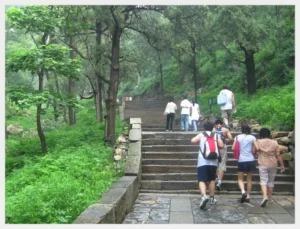
Cultural and Historical Significance: Mount Tai has been a place of worship and pilgrimage for over 3,000 years. It is considered a symbol of Chinese culture and has played a vital role in the development of Taoism, Confucianism, and Buddhism in China. Emperors of various dynasties traditionally ascended Mount Tai to hold ceremonies and seek blessings for the prosperity and well-being of the nation.
UNESCO World Heritage Site: Mount Tai was designated as a UNESCO World Heritage Site in 1987 for its natural and cultural importance. It represents an outstanding manifestation of ancient Chinese civilization and showcases the harmonious relationship between nature and human culture.
Geographical Features: Mount Tai rises to a height of 1,545 meters (5,068 feet) above sea level, making it the highest peak in the Shandong province. It is characterized by a series of granite peaks, deep valleys, lush forests, and flowing springs. The mountain offers breathtaking scenery and stunning views of the surrounding landscapes.
2. Choose Your Travel Season
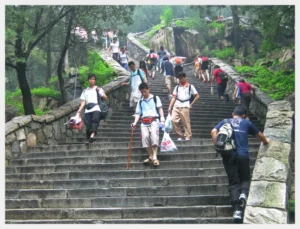
The best time to hike Mount Tai is during the spring (April to June) and autumn (September to November) seasons.
In spring, the weather is mild and pleasant, with blooming flowers and lush greenery, creating a picturesque atmosphere. The temperatures are comfortable for hiking, and you can enjoy the beauty of the mountain without the extreme heat or cold. However, keep in mind that spring is also a popular time for tourists, so the trails might be busier.
Autumn is another great time to hike Mount Tai. The weather is clear and cool, with the added bonus of witnessing the stunning fall foliage as the leaves turn vibrant shades of red, orange, and yellow. The crowds are generally thinner compared to the spring season, allowing for a more peaceful hiking experience.
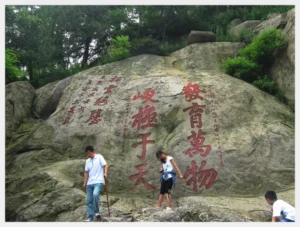
Avoid hiking Mount Tai in summer (July to August) as it can be hot and humid, making the ascent more challenging. Additionally, winters (December to February) can be extremely cold with snow and ice, which makes hiking conditions difficult and potentially dangerous.
Before hiking Mount Tai, it’s important to check the weather forecast and prepare accordingly, as conditions can change rapidly. Proper hiking gear, good physical condition, and a well-planned itinerary are essential for a safe and enjoyable hiking experience.
3. How to get to Mount Tai
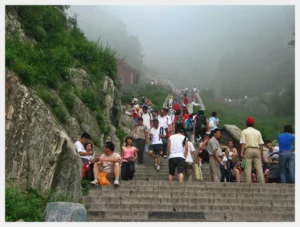
To get to Mount Tai, you have a few transportation options depending on your starting point:
By Air:
The nearest major airport to Mount Tai is Jinan Yaoqiang International Airport (TNA) in Jinan, Shandong Province. From the airport, you can take a taxi or a shuttle bus to Jinan Railway Station, and then continue by train or bus to Mount Tai.
By Train:
There are direct trains from major cities like Beijing, Shanghai, and Jinan to Tai’an, the city located at the base of Mount Tai. From Beijing or Shanghai, you can take a high-speed train to Tai’an Railway Station. From Jinan, you can take a high-speed train or a regular train to either Tai’an Railway Station or Taishan Railway Station. Both stations are in close proximity to Mount Tai.
By Bus:
There are also long-distance buses that connect Tai’an with nearby cities and provinces. You can check with local bus terminals or travel agencies for bus schedules and routes to Tai’an. From Tai’an, you can take a local bus or taxi to Mount Tai.
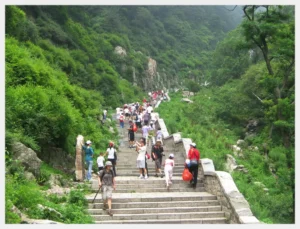
Once you arrive in Tai’an, you will need to make your way to the Mount Tai Scenic Area. You have the option of taking a bus or hiking the approximately 6-kilometer-long (3.7 miles) route from the city to the foot of the mountain.
To enter the Mount Tai Scenic Area, you will need to purchase an admission ticket. Once inside, you can choose to hike the various paths and trails, or take a cable car for a quicker ascent to the summit. It is important to plan your visit in advance, especially if you are hiking, as there are several paths with different difficulty levels.
In any case, it is advisable to check for transportation options, routes, and schedules specific to your starting point and make necessary arrangements based on your preferences and available time.
4. Entrance Fees
Pay the entrance fee at the base of the mountain. Ticket prices vary depending on the time of year and whether you want to take a cable car or hike.。
Mount Tai Entrance tickets:
Peak Season: 115 yuan/person (February – November
Off-season: 100 yuan/person (December – January).
Note: Valid for three days.
Zhongtianmen Cable Car:
one-way: 80 yuan/person, round trip: 140 yuan /
5. Research Accommodation Options
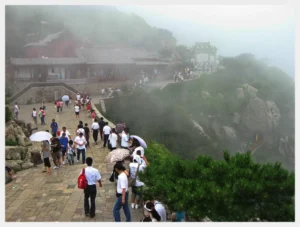
Look for accommodations in the nearby city of Tai’an or at the foot of Mount Tai. There are various options available, including hotels, guesthouses, and hostels.
There are hotels and guesthouses both at the base and on the mountain itself. Consider booking your accommodation in advance, especially during peak tourist seasons.
Consider factors such as location, budget, and amenities in choosing your accommodation.
6. Cable Car vs. Hiking
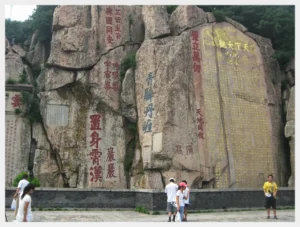
You can choose to hike up Mount Tai or take a cable car. Hiking is a challenging but rewarding option. If you prefer a more relaxed experience, consider the cable car.
Hiking and Ascending the Summit: Mount Tai offers several hiking trails and routes to reach its summit. The most popular and traditional route is the Eastern Route (Dongyue). It starts from the Red Gate (Hongmen) and takes you through the Heavenly Street (Tianjie), which is lined with traditional architecture, temples, and ancient trees. The hike typically takes 4-6 hours, depending on your fitness level and pace.
7. Temples and Cultural Sites
Mount Tai is dotted with numerous temples, pavilions, and cultural sites that add to its allure. The most famous is the Dai Temple, a complex of buildings dedicated to the worship of the God of Mount Tai. Other notable sites include Bixia Temple, Puzhao Temple, and the Eighteen Bends.
8. Sunrise and Sunset Views
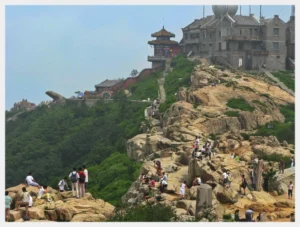
Watching the sunrise or sunset from the summit of Mount Tai is a popular activity.
The mountain offers stunning panoramic views as the sun rises or sets, casting a golden glow over the landscape.
It is a breathtaking and memorable experience for visitors.
9. What to Pack
Check the weather during your visit to Mount Tai and pack appropriate clothing. Wear comfortable hiking shoes, bring a daypack with essentials like water, snacks, sunscreen, and a hat.
Also, consider bringing warm layers, as temperatures can be cooler at higher elevations.
10. Exploring Tai’an
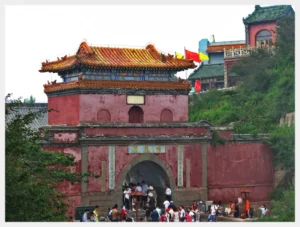
If you have extra time, explore Tai’an city, which has its own historical and cultural attractions, such as the Dai Temple.
Festivals and Events in Tai’an: Mount Tai hosts various cultural events and festivals, such as the Confucius Ceremony and Mount Tai International Climbing Festival.
These events showcase the rich cultural heritage and customs associated with the mountain.
11. Transportation Back
When you’re ready to leave Mount Tai, you can return to Tai’an and continue your journey by train or bus to your next destination.
Visiting Mount Tai is a remarkable journey that allows you to immerse yourself in Chinese history, culture, and natural beauty. It offers a perfect blend of spiritual significance and awe-inspiring landscapes, making it a must-visit destination for travelers exploring the Shandong province.
If you have any questions or queries, then please feel free to drop us a line.

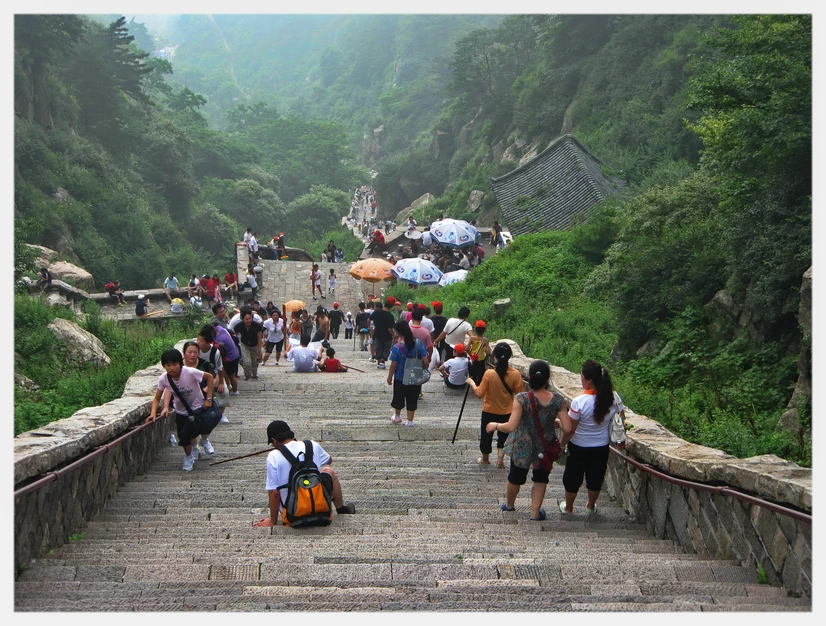


Hi,
Thanks for the website, Mount Tai (Mount Taishan): A Guide for Foreign Visitors.
I will be hiking Taishan next month. I am a foreigner. Can I confirm in point form (for clarity of questions and answers) and hope you can assist on the following:
1. Do I need to register online before the hike? (I need to register online before hiking Mt Hallsan in Jeju, South Korea.)
2. Is the entrance fee payable at the foot of Taishan the only fee payable? (I am not keen on other attractions that are chargeable and my main interest is to hike up and down Taishan which will easily take up more than 10 hours for me…)
3. If I were to hail a car, what is the destination I should input on my Alipay App so that I will be at the exact location where the payment of entrance fee is? (China is very big, and there are many drop off spots at a single site…)
4. Is there anything else I should do and/or pay online before the hike? (I certainly do not wish to fly all the way to Jinan, take a high speed train to, and book a hotel at, Tai’an, and cannot hike for whatever reasons…)
Thank you very much!
Warmest Regards,
Jack
——————————————-
Hi Jack,
Thank you for your thoughtful questions—and I’m so glad you found our Mount Taishan guide helpful! It’s great to hear you’re planning a hike up Taishan next month. Below are answers to each of your questions to help you prepare for an enjoyable and smooth trip:
1. Do I need to register online before the hike?
Yes, all visitors—foreigners included—are required to book tickets in advance with real-name registration. You can reserve your ticket through the official “泰山景区” (Taishan Scenic Area) WeChat account by selecting “微信购票” (WeChat ticket purchase).
Alternatively, you can also book through major travel platforms like Ctrip (Trip.com).
Tickets can be reserved up to 7 days in advance, and we recommend booking early—especially around weekends or holidays when the number of visitors may be limited.
Make sure to use your passport information during booking and bring your passport for entry. At the gate, please use the manual check-in lane.
2. Is the entrance fee the only fee I need to pay?
Yes—if your plan is to hike up and down without taking a shuttle bus or cable car, the only required fee is the entrance ticket:
Admission Fee: RMB 115 per person (as of 2025)
Ticket Validity: Valid for 3 days after first use; if you wish to re-enter the park during this period, you can rebook for free via the WeChat account.
Optional additional fees:
If you follow the Red Gate (Hongmen) trail 红门路线 (the classic hiking route), there are no extra transportation costs.
If you choose other routes like Tianwaicun or Peach Blossom Valley (天外村或桃花峪路线), you’ll need to take a shuttle bus (RMB 35 one way), as these routes are not purely for hiking.
3. What destination should I enter in my Alipay or ride-hailing app?
If you’re hiking the classic Red Gate route, which is the best for a full hike from bottom to top, set your destination as:
“泰山红门游客中心” or “红门登山口” (Taishan Red Gate Tourist Centre or Red Gate Hiking Entrance)
(Please use these exact Chinese terms for the most accurate drop-off location.)
Other entrances like Tianwaicun are more suitable if you’re combining hiking with a bus or cable car.
4. Is there anything else I should do or pay for online before the hike?
Weather: Taishan weather can be unpredictable, and temperatures at the summit can be much colder. Check conditions via the official WeChat account “泰山景区” before your hike.
Gear Tips:
Lightweight hiking shoes
Warm clothing (especially for early morning or evening hikes)
Flashlight (if hiking at night), trekking poles (optional, available at the base)
A small amount of cash (mobile payment is widely accepted, but signal can be unstable in some areas)
Accommodation (if needed):
If you’re planning to stay overnight for the sunrise, book a summit hotel in advance. Rooms can be pricey, or alternatively, you can start hiking in the early hours of the morning.
Bonus Tips:
Hiking time from Red Gate to the summit (South Heavenly Gate): approx. 5–6 hours up, 3–4 hours down
Be cautious on steeper sections like the famous “Eighteen Bends,” and avoid hiking dangerous sections in the dark if possible.
I hope this information helps you feel well-prepared and excited for your upcoming Taishan adventure! If you have any other questions along the way, don’t hesitate to reach out.
As travel conditions and policies can sometimes change, we’d also really appreciate it if you could share any updates or experiences after your hike. Your feedback could be incredibly helpful to future travelers planning their own journeys to Mount Tai.
Wishing you a safe, memorable, and truly rewarding climb!
Warmest regards,
Daniel
Ruqin China Travel